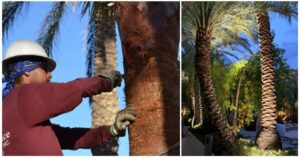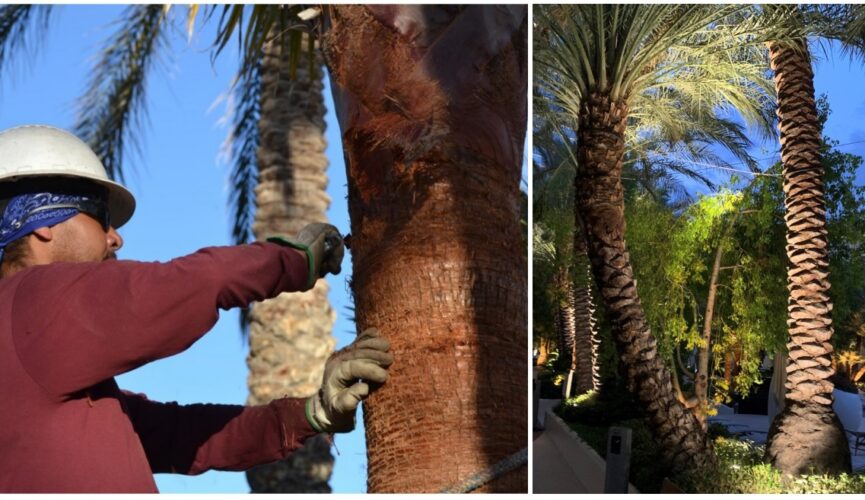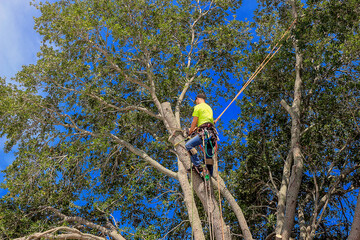Palm trees are a staple of Southern culture. They provide beauty and add to your property’s curb appeal. For more information, just visit Palm Tree Trimming Phoenix to proceed.
Unfortunately, over time, they can begin to look unkempt. The most common issue is dead fronds that can pose a safety hazard to property or people.

One way to help reduce these fronds is by having your palm tree skinned. Many homeowners choose to peel their palm trees for aesthetic reasons and health benefits for the palms themselves.
Palm trees are an iconic feature of Southern, bringing beauty and style to properties. However, like any other tree, they need routine maintenance to thrive. One of the most important maintenance tasks for palms is skinning, which involves removing dead fronds from the tree. It’s vital to get this done annually, but there are other reasons to have it performed.
Palms grow quickly and often develop a lot of dead fronds, which are unsightly, pose a fire risk, and can block sunlight from reaching the rest of the tree. If left to accumulate, they can also cause damage to nearby buildings and cars. Having them skinned removes these hazards while allowing the healthy parts of the tree to grow.
Skinning your palm tree removes some pests that would otherwise infest the tree. Dead fronds provide a habitat for rodents and other pests, who will chew on the tree’s bark, causing irreparable harm. Skinning removes these pests and prevents them from spreading to other areas of the property.
In addition, the fronds can provide shelter for mosquitoes and other insects, which can harm people and pets. Having the dead fronds removed reduces the number of mosquitoes around your home and helps to keep them away from your guests.
The same is true for other insects, which are attracted to the fronds and can be carried indoors. Skinning regularly can help to keep these insects at bay and protect your family’s health and comfort.
A final benefit of skinning your palm tree is that it improves its overall appearance. Old fronds are unsightly and can create a fire hazard, while new ones are brighter and more attractive. While some people may attempt to skin their palms, it is important to have this task done by a professional with the right equipment. It’s a dangerous job, and untrained trimmers can injure themselves or hurt the tree. Additionally, cutting too deep into the trunk can leave scars and infections that interfere with nutrient transfer.
Palm trees are attractive in a landscape setting but need regular maintenance to keep them healthy. One of the most important reasons to skin a palm tree is to prevent insects and rodents from nesting in dying fronds. These pests can cause serious damage to the palm if left unattended. Dead fronds will quickly transfer diseases to other parts of the tree. Professional tree services will ensure that all dying fronds are removed from the palm.
The removal of the fronds also allows nutrient flow into the trunk. This is a vital aspect of the health of a palm tree and can help avoid diseases such as fungus. A skilled tree service will sanitize their trimming equipment before cutting the fronds off a palm and ensure they are not cutting too deep into the trunk. If cuts are too deep, they can open the palm tree to infection and rot, so homeowners must hire professionals for their palm care and skinning.
In addition to rotting, palms can become infested with pests that are not easily controlled with conventional insecticides. The Rhinoceros palm weevil (RPW) is a major pest that can cause extensive damage to oil palms in plantations. This insect attacks the leaves and crowns of a palm by digging into the leaf axils. They create holes, notches, and grooves on the abaxial surface of the leaves and can destroy a significant portion of the photosynthetic area. This insect has been able to develop resistance to traditional insecticides, so people must take a comprehensive approach to palm pest control.
A good palm tree skinning service will eliminate the problem of RPWs while providing valuable health benefits to the tree and the property owner. Having your palm tree professionally skinned at least once a year is important. Attempting to perform this work alone is extremely dangerous and can lead to injury or property damage. An experienced professional will use pole saws and safety harnesses to remove the fronds from your palm tree safely.
Palms are an iconic part of the Southern lifestyle. But their beauty can quickly become an eyesore if they are not maintained. That’s why it is important to have a professional trimmer perform regular skinning to preserve the appearance of your palm trees.
Unlike evergreens like pine and cypress, palm trees have a lot of dead fronds that can stick to the trunk and create an unsightly, spiky look. In addition, if the fronds break off from the tree and fall, they can pose a danger to people or vehicles. This is especially true for commercial properties where the landscaping makes a first impression on clients and customers.
Removing the old fronds helps the palm tree look more lush and vibrant and reduces the risk of debris falling off the tree. It also helps to keep the tree healthier, as dead fronds can be a breeding ground for pests. Keeping the fronds on the palm tree can also be a safety hazard, so it is important to have them removed regularly.
The stems of palm trees are very rigid due to a special type of tissue called the primary xylem that transports nutrients between the roots and the crown. The rigidity of the stems also gives them a unique structural form. The branches can be slender and tubular or robust and erect, with some species growing to very tall heights.
Another feature differentiating palm trees from other trees is the lack of a cambium. This means that, unlike dicot plants, palms cannot graft with the roots of different palms. Because of this, it is more difficult to propagate new plants from the cuttings of existing palms. This also contributes to the overall need for uniformity in the appearance of palm trees since each has a distinctive shape. While palm trees’ erect, straight stems and spiky appearance appeal to some, others prefer a more natural, rounded shape. To achieve this, a palm tree can be skinned to remove the bark and expose the underlying tissue. This process is sometimes referred to as “ringing” or debarking. It is important to sanitize all trimming equipment before the skinning process begins, and it should be done by a professional who understands the proper technique.
Palm trees are iconic in many yards, parks, and businesses. Like other trees, palms require regular care and maintenance to remain healthy. Besides trimming and pruning, the health of your palm tree can be enhanced through skinning, also known as shaving or skimming. The process removes the rough webbing of “skin” left behind by years of trimming dead fronds and helps the tree look newer and more tropical.
Unlike deciduous trees, which naturally shed dead leaves or fronds after some time, palms retain fronds for much longer than other species. When a frond dies, it becomes very heavy and can create a safety hazard for pedestrians. The weight of the fronds can cause the tree to lose balance and potentially snap. Moreover, the fronds are often full of rot and can become a breeding ground for pests and diseases.
The fronds can also clog the tree’s water and mineral intake. When this happens, the nutrients from the tree’s roots can be directed toward the fronds instead of the trunk, which is detrimental to the tree’s health.
When the fronds are removed, the tree is better able to transport water and nutrients from its roots up to its crown and fronds, keeping it healthy and preventing it from becoming overburdened. In addition, the fronds are often a habitat for pests, including leatherwing beetles and codling moths, which can damage outdoor furniture or infest homes.
Skinning a palm tree can be dangerous and should only be performed by trained professionals. It involves using sharp tools and is done at high heights, making it very easy to injure yourself or damage the tree. A professional palm tree trimmer and skinner has years of experience, specialized equipment, and top-notch customer service to ensure the job is done correctly.
The benefits of palm tree skinning are clear, especially when performed by a professional. However, you must choose the best tree service company to complete the work.


 It’s Easy To Maintain
It’s Easy To Maintain